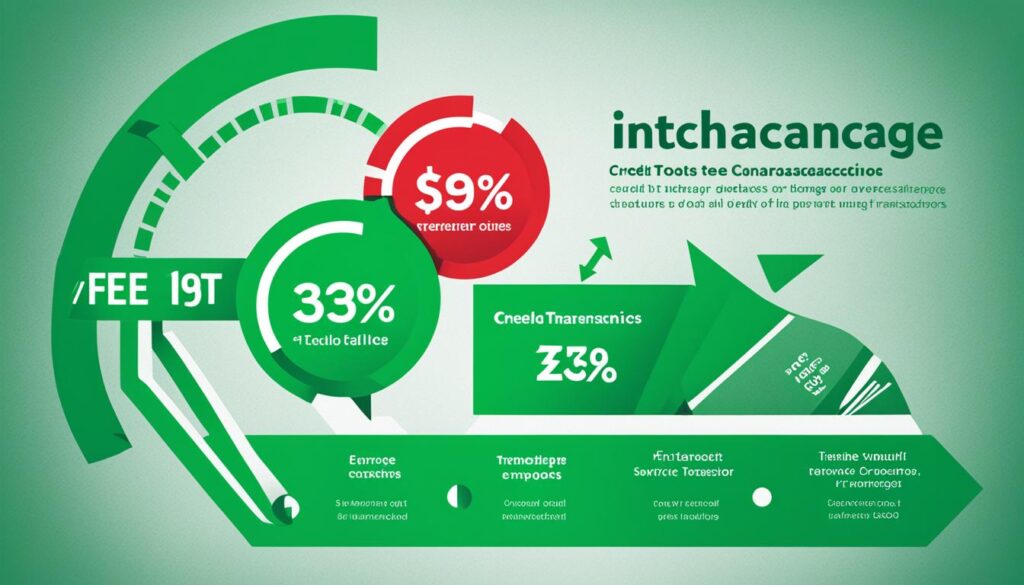Small and medium-sized businesses (SMBs) may lose up to 3% of their annual revenue to credit card fees. For SMBs operating in industries with large transaction amounts, it is essential to comprehend and manage the complexities of credit card processing fees. These charges can greatly impact profits, so it is important to find a good balance between customer convenience and financial stability.
Key Takeaways:
- Small and medium-sized businesses can lose up to 3% of their revenue to credit card fees annually.
- Understanding credit card processing fees is crucial for SMBs in sectors with substantial transaction amounts.
- It is important to strike a balance between customer convenience and financial sustainability when navigating credit card fees.
Common Options for Handling Credit Card Processing Fees
In this article, we’ll explore three common options for handling credit card processing fees. SMBs have several choices when it comes to managing these fees efficiently. Let’s examine the pros and cons of each option to help determine the best approach for your business.
Surcharging
One option for handling credit card fees is surcharging. This involves adding an additional fee to the price of a good or service when customers pay with a credit card. Surcharging allows businesses to pass on the cost of credit card processing to the customers directly, helping to offset the fees incurred.
While surcharging can help alleviate the financial burden on the business, it’s important to consider the potential impact on customer satisfaction. Some customers may be turned off by the additional fee, which could result in lost sales or negative online reviews. It’s essential to evaluate your customer base and determine if surcharging aligns with their preferences and expectations.
Absorbing the Fees
Another option is absorbing the credit card fees by incorporating them into the overall pricing structure. With this approach, the business covers the cost of credit card processing without explicitly charging customers an additional fee.
Absorbing the fees can enhance customer satisfaction by avoiding any surprises or additional charges at checkout. This transparent pricing strategy may promote customer loyalty and repeat business. However, it’s crucial to carefully evaluate your pricing strategy to ensure that it remains profitable while covering the expenses associated with credit card processing.
Raising Prices
One alternative is to raise prices across the board to account for the credit card processing fees. By adjusting the overall pricing structure, the business can spread the cost among all customers, regardless of payment method.
While raising prices can help cover the credit card fees without imposing a specific fee on credit card users, it’s important to consider the potential impact on competitiveness. Higher prices may deter price-sensitive customers and make your business less appealing compared to competitors with lower prices. It’s essential to strike a balance between covering costs and remaining competitive in the market.
Ultimately, choosing the right option for handling credit card processing fees depends on your business’s unique circumstances, customer preferences, and financial goals. Consider the pros and cons of each approach and evaluate which option aligns best with your overall business strategy.

Surcharging: Pros and Cons
Surcharging is an option where an additional amount is tacked on to the price of a good or service at the time of purchase. As a business owner, this is called surcharging when you accept credit cards. The pros of surcharging include having the fees covered by the customer, relieving the business of the cost burden. However, the cons include the potential dissatisfaction and loss of business due to extra fees, as well as discouragement of credit card usage in the future.
Pros of Surcharging
- The fees are covered by the customer, reducing business costs.
- Surcharging can be a source of additional revenue for the business.
- Businesses can maintain competitive prices by passing on the cost to the customer.
Cons of Surcharging
- Customers may be dissatisfied with the additional checkout fee.
- Extra fees may discourage customers from completing purchases.
- Surcharging can create negative associations with the business and impact customer loyalty.
“While surcharging can provide immediate relief from credit card processing fees, it’s important for businesses to consider the potential impact on customer satisfaction and long-term relationships.”

Comparison of Surcharging with Other Options
| Surcharging | Absorbing the Fees | Raising Prices | |
|---|---|---|---|
| Customer Convenience | Can be viewed as inconvenient due to additional fees. | Convenient for customers as fees are hidden within the overall pricing. | No additional fees, maintaining customer convenience. |
| Business Cost | Fees are covered by the customer, reducing business cost. | Business bears the cost of processing fees. | Business spreads the cost across all customers. |
| Customer Satisfaction | May lead to dissatisfaction and potential loss of business. | Transparency in pricing can lead to higher customer satisfaction. | Maintains customer satisfaction as prices remain unchanged. |
| Competitiveness | May impact competitiveness if customers perceive the surcharge as a deterrent. | Pricing appears simpler and more transparent, potentially enhancing competitiveness. | Pricing remains competitive but risk of customer dissatisfaction with price increases. |
Absorbing the Fees: Pros and Cons
In order to navigate credit card processing fees, businesses have the option of absorbing these fees into their overall pricing structure. This approach involves spreading the cost across all customers, not just credit card users. While there are advantages to absorbing the fees, there are also some drawbacks to consider.
Pros of Absorbing the Fees
- No Additional Fee: One of the benefits of absorbing the fees is that customers do not see an additional fee at the time of purchase. This eliminates any potential negative reactions or frustrations that may arise from customers seeing an extra charge on their transactions.
- Transparent Pricing: By incorporating the fees into the overall pricing structure, businesses can present a simpler and more transparent pricing model to their customers. This can enhance trust and improve customer satisfaction.
- Encourages Credit Card Usage: Since there are no penalties or additional fees associated with credit card payments, customers are more likely to use their cards for transactions. This can be beneficial for both the business and the customer, as credit cards offer convenience and potential rewards.
Cons of Absorbing the Fees
- Business Bears the Processing Fees: When absorbing the fees, the burden of the processing fees falls on the business itself. This can impact the profitability of the business, especially for small or medium-sized businesses with tight budgets.
- Less Transparency: While absorbing the fees simplifies the pricing structure, it may lead to less transparency regarding the specific fees being charged. Customers may not have a clear understanding of the breakdown of fees and how they contribute to the overall pricing.
It is important for businesses to carefully consider the pros and cons of absorbing the fees before making a decision. While it offers advantages such as transparency and customer satisfaction, it also comes with the cost of bearing the processing fees. Understanding the specific needs and financial capabilities of the business can help determine whether absorbing the fees is the right approach.

Incorporating credit card processing fees into the overall pricing structure can simplify pricing and improve customer satisfaction. However, businesses should carefully analyze the financial implications and consider alternative options to ensure a balanced approach.
Raising Prices: Pros and Cons
When it comes to handling credit card processing fees, raising prices is a viable option that business owners can consider. With this approach, the fees are built into the overall pricing structure by raising prices across the board. This section explores the pros and cons of adopting this strategy.
Pros of Raising Prices
- Costs spread across all customers: By incorporating the fees into the pricing structure, the cost burden is shared among all customers, not just credit card users. This helps maintain fairness and avoids singling out specific payment methods.
- No extra fee or surcharge: Raising prices eliminates the need for an additional fee or surcharge on credit card transactions. Customers appreciate transparent pricing without hidden charges, enhancing trust and loyalty.
- Avoidance of customer turn-offs: Surprises at the checkout counter can be a major source of dissatisfaction. Raising prices to include processing fees removes the potential for unexpected extra charges, preventing customer turn-offs and transaction abandonment.
Cons of Raising Prices
- Potential for reduced competitiveness: Increasing prices may make a business less competitive compared to other players in the market. Customers may opt for lower-priced alternatives, especially if they perceive the price hike to be significant.
- Customer unhappiness: Price increases, even when justified, can lead to customer dissatisfaction. Some customers may resist accepting the higher prices and seek alternative solutions or providers.
Before implementing a price increase, business owners need to carefully assess the potential impact on customer satisfaction and overall competitiveness. While raising prices can help cover credit card processing fees, it’s crucial to strike a balance that maintains customer loyalty and ensures a competitive position in the market.
Let’s dive deeper into the different credit card processing fees and gain a better understanding of their components and implications for businesses.
Absorbing the Fees: The Best Solution for SMBs
When it comes to handling credit card processing fees, small businesses need to find the best solution that ensures customer satisfaction and financial sustainability. Among the three options available, incorporating the fees into the overall pricing structure proves to be the most favorable choice for SMBs.
This strategy strikes a balance between customer convenience and business profitability. By absorbing the fees, small businesses can avoid the potential drawbacks associated with surcharging or raising prices, such as customer dissatisfaction and loss of business.
By incorporating the fees into the pricing structure, businesses can provide transparent and simplified pricing to their customers. This approach eliminates the need for extra surcharges or visible price increases, enhancing customer satisfaction and loyalty.
Moreover, absorbing the fees allows small businesses to remain competitive in the market. By not placing an extra burden on customers, they can continue accepting credit cards without deterring potential buyers.
The Benefits of Absorbing the Fees:
- Improved Customer Satisfaction: By incorporating the fees into the overall pricing structure, businesses can provide a seamless payment experience, with no unexpected charges or additional fees, which leads to increased customer satisfaction and loyalty.
- Financial Sustainability: Absorbing the fees helps businesses maintain their financial stability by preventing significant profit reductions caused by absorbing surcharges or covering increased costs due to raised prices.
- Competitiveness: By adopting a pricing strategy that doesn’t burden customers, businesses can remain competitive in their market, attracting more customers and staying ahead of their competitors.
Overall, absorbing the credit card processing fees into the overall pricing structure is the best solution for SMBs. It ensures customer satisfaction, financial sustainability, and competitiveness, enabling small businesses to thrive in the competitive landscape while providing a seamless payment experience for their customers.

Understanding Credit Card Merchant Fees
Credit card merchant fees are an integral part of accepting credit card payments for purchases. These fees are charged by credit card companies, such as Visa or Mastercard, and contribute to the overall cost of processing transactions. It’s important for businesses to have a clear understanding of these fees in order to manage their finances effectively and make informed decisions.
When a customer uses a credit card to pay for a purchase, the merchant is required to pay certain fees to the credit card company. These fees can vary between different cards and different service providers, so it’s crucial to carefully consider the fee structures offered by various payment processors.
Merchant Tip: Compare the credit card merchant fees offered by different service providers to find the best fit for your business and maximize your profits.
Credit card merchant fees consist of several different components. The first component is interchange fees, which are charged by card issuers. These fees cover the costs associated with processing the transaction, including handling fees and fraud prevention measures. Interchange fees can vary based on factors such as the transaction amount, the merchant category, the type of card used, and the method of processing.
The next component of credit card merchant fees is assessment fees. These fees are paid to card networks, such as Visa or Mastercard, for the privilege of accepting their cards. Assessment fees are usually lower than interchange fees and contribute to the overall cost of processing credit card transactions.
Lastly, payment processing fees are another important component of credit card merchant fees. These fees are charged by payment processors for the actual processing of the credit card payment. They cover the cost of services such as payment gateways, data security, fraud prevention, and customer support.
It’s worth noting that credit card merchant fees can differ significantly between different service providers. Factors such as the size of the business, the industry, and the volume of transactions can also impact the fees charged. Therefore, it’s essential for businesses to carefully evaluate and compare the fee structures offered by various service providers to determine the most cost-effective solution for their specific needs.
Comparison of Credit Card Merchant Fees
| Fee | Description | Example |
|---|---|---|
| Interchange Fees | Fees charged by card issuers to cover processing costs and fraud prevention. | 1.5% + $0.10 per transaction |
| Assessment Fees | Fees paid to card networks for accepting their cards. | 0.10% of transaction volume |
| Payment Processing Fees | Fees charged by payment processors for processing credit card payments. | 2.9% + $0.30 per transaction |
Understanding credit card merchant fees is vital for businesses to ensure they have a clear picture of the cost implications of accepting credit card payments. By comparing fee structures, businesses can find the most suitable payment processing solution that strikes a balance between cost-effectiveness and the level of service required. This not only helps businesses manage their finances effectively but also contributes to overall customer satisfaction and financial sustainability.
Types of Credit Card Processing Fees
When it comes to credit card processing, it’s important for small businesses to understand the different types of fees involved. By familiarizing themselves with these fees, business owners can better manage their finances and make informed decisions about their payment processing strategies.
Interchange Fees

Interchange fees are charges imposed by card issuers to cover expenses such as handling costs and fraud prevention. The amount a business has to pay in interchange fees varies based on several factors, including the transaction amount, merchant category, card type, and processing method. These fees can significantly impact a business’s bottom line, so it’s essential to carefully review and understand the terms set by the card issuers.
Assessment Fees
Assessment fees are paid to card networks, such as Visa or Mastercard, for the privilege of accepting their cards. These fees are typically lower than interchange fees and contribute to the overall cost of accepting credit card payments. The specific assessment fees are determined by the card networks and can vary depending on factors such as the volume of transactions and the merchant’s industry.
Payment Processing Fees
Payment processing fees encompass the costs associated with handling and processing credit card payments. These fees can include various components, such as payment gateway fees, monthly service fees, and per-transaction charges. Payment processors, such as Stripe or Square, typically charge these fees to cover their operational expenses and provide businesses with the necessary infrastructure for accepting credit card payments.
Understanding these different types of credit card processing fees is crucial for small business owners. It allows them to accurately calculate the costs associated with accepting credit card payments and make informed decisions about their payment processing options. By carefully managing these fees, businesses can optimize their revenue and ensure financial sustainability.
Conclusion
In the complex landscape of small business operations, finding the right strategy for handling credit card processing fees is crucial. SMBs must carefully weigh the pros and cons of different options while considering factors such as customer satisfaction, financial sustainability, and competitiveness in order to strike a balance in their merchant services.
A favorable solution for small businesses is incorporating the fees into the overall pricing structure. By doing so, businesses can foster customer satisfaction and loyalty while maintaining financial viability. This approach avoids the potential drawbacks of surcharges or price hikes, ensuring a transparent and seamless payment experience for customers.
Furthermore, by adopting a pricing structure that absorbs credit card fees, SMBs signal a commitment to customer satisfaction. This fosters a positive relationship between businesses and their clientele, resulting in improved customer loyalty and higher chances of repeat business.
Ultimately, in order to achieve financial sustainability and customer satisfaction, small businesses must approach credit card fees strategically. By choosing an option that aligns with their specific needs, goals, and customer base, SMBs can navigate the complexities of merchant services while maximizing their overall business performance.









